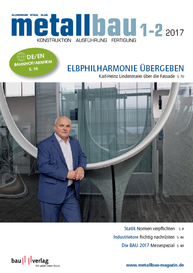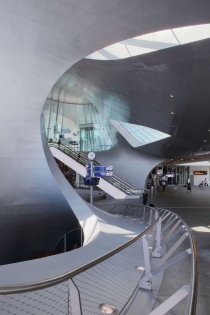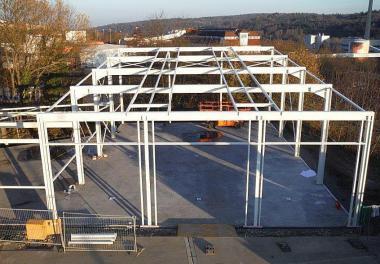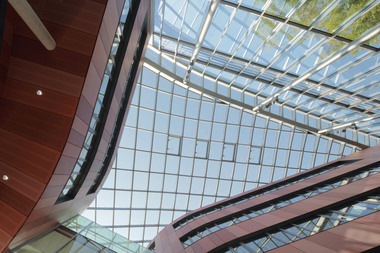“We start the whole process with the end in mind.”
metallbau: Mr. Husmann, the CIG Group not only does projects in architecture, but also shipbuilding and renewable energies. Do you see any synergies?
Uwe Husmann: In terms of the customers, not really, because they are not part of the same markets. People of course know about our know-how and expertise in 3D transformations.Internally, process-related synergies arise. Both while forming and welding. The requirements we receive from very different customers in relation with the quality of our parts and components challenge our path for continuous improvement. As a general rule in architecture, you have higher surface requirements, which are achieved both by high welding quality and by the treatment of the surfaces after welding. Experience acquired in this field can be applied to other products, like welding quality and accuracy.
metallbau: How are the shares in business divided?
Husmann: When Ostseestaal was founded in 2000, we carried out about 80 % of the orders for the shipbuilding segment. Everything else, like architecture and renewable energy, accounted for about 20 % of our activity. Since the shipping crisis in 2008/2009, the order situation has almost reversed.
metallbau: How do you aquire new projects?
Husmann: In the past, shipbuilders came to us specifically and ordered shipbuilding components. At that time, we had a unique selling point on a regional scale that focused on the cold forming of metals. Since we reversed our proportion of orders, we have considerably expanded our customer base and actively entered the markets of architecture and renewable energy. There are also cooperations within the CIG Group. Architecture projects are coordinated by our Dutch colleagues, but with the active participation of our local engineers. The Arnhem train station is a good example of this. In the meantime, we are carrying out architectural projects across Europe and we are increasingly asked to do projects abroad. We have seen that there is also a high esteem for the quality work of German manufacturers in architectural projects. In the field of renewable energy, we are equally active from our location, and not just from a sales point of view. We are also designing new products, like solar boats. In the components that we supply to the aerospace industry, our experience with accuracy requirements in architecture is often the perfect synthesis.
metallbau: You are also suppliers for wind power plants, but your rotors usually consist of carbon fibre reinforced plastic (CFRP). Where do you find the skills for your metal construction?
Husmann: We supply wind turbine manufacturers with the modules that enable them to produce good, robust and lightweight CFRP components for rotor blades. We are not limited by size in the production of these instruments. The limit of the rotor diameters is determined by the ability to deliver it to the assembly site, which is often a challenge for logistics.
metallbau: How do you go about the production of such large frames in terms of their organization?
Husmann: First, we obtain an overall concept, the complexity of which we break down into individual components that are manageable and that can be worked on in a structurally methodical manner. Nevertheless, they need to be connected again at the end. We consider our forming machines in terms of what they can achieve. Finally, technical effects need to be taken into account, such as the know-how on welding shrinkage. Similarly, we must not lose sight of the required logistics performance, both internally and externally. A successful building method always needs to be thought out from the end, in other words, from the final assembly at the target location.
metallbau: What machines do you work with?
Husmann: In 2000, Ostseestaal, a spin-off of the Dutch parent company in Stralsund, started production with two plasma cutting machines and seven large presses. That is why the parent company invested 25 million Euros in Stralsund. In a new factory building, we have 17 crane systems with different load increments. For our cold forming, presses, rollers and turning benches are important. At the presses, we work with individual moulds and templates, with which we transform the metal sheet up to 60 millimeters thick. These templates are created with the use of digital models. The newly formed individual parts form segments that are joined together to form an assembly unit. We fragment geometrically undefined free forms into their individual components – such as cylinders, cones, and conus – deforming them cold in order to reassemble them.
metallbau: In general, are European standards or certifications a problem for Ostseestaal?
Husmann: We do not have any problems with almost anything that concerns ISO, Euro-Norm or DIN. Every now and then we have to carry out process tests for welding processes with new materials, sometimes a specific process environment will come along. Even certifications for foreign European customers based on their national regulations and standards do not pose any problems for us. We recently received the certification from the Los Angeles Building Department to enable us to be approved for architectural projects in California.
metallbau: On your website, you mention the reduction in the number of welds with nozzles. Can you explain this?
Husmann: Until now, propeller nozzles have been assembled and welded from many individual parts. Various requirements must be taken into account in order to achieve the required accuracy, in particular with regard to the welding shrinkage. With a system that has been developed internally, we have managed to no longer break down the complexity into the smallest components, but rather to assemble the nozzle from a few large components. For this purpose, we have developed a forming machine specifically for nozzles, which allows us to reduce the number of welds by 60–70 %. Nozzles are rotation bodies that have outer contours that can be deformed over the respective central point. We no longer disassemble the nozzle volume – as we did previously – over the circumference of the casing, but rather divide it into layers. In this way, we are rolling complete rings, which are either designed as a cylinder or as a cone, and are therefore transferred to the large forming machine. Ultimately, we can weld together three outer and three inner components. However, we are also innovative in our welding technology. We are able to clamp large propeller nozzles and move them, so that we can always weld in the best position: We do not move the welding source, but rather the workpiece.
metallbau: Since when are such organic structures such as the Arnhem train station or the Porsche pavilion visible?
Husmann: First of all, I would like to remind you of the Paris World Exposition and the Eiffel Tower of 1899: Steel structures in architecture have been around for quite some time, welding structures have only existed for several decades. It is the materials that have changed fundamentally: The Eiffel Tower is made of cast iron, it also has no welding, but rather it was riveted. Nowadays, three-dimensional components can be manufactured quite simply and much easier from the materials themselves, because they tolerate the mechanical properties. The surfaces can also be processed differently compared to what was done in the past, for example using novel grinding techniques. Furthermore, the dyes and corrosion protection that are used are now completely different: It is possible to define the surface texture solely by means of coatings. Finally, we should mention the current welding processes and welding consumables, which considerably reduce the welding shrinkage. In principle, I would say that with the start of the new millennium, the demand for steel freeforming in architecture has significantly increased.⇥red ◊




